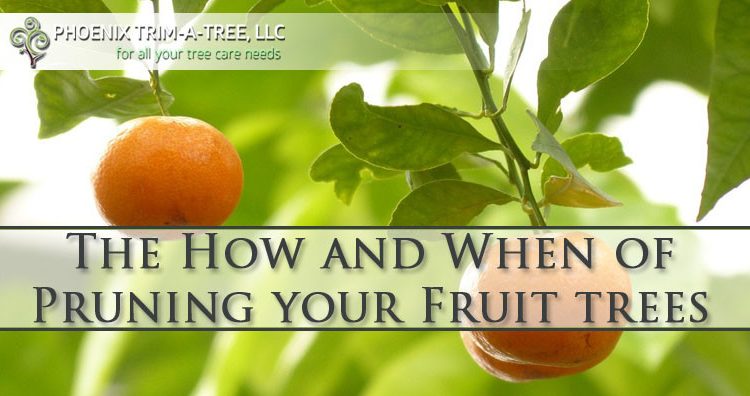The How and When of Pruning your Fruit Trees
THE HOW AND WHEN OF PRUNING YOUR FRUIT TREES
GET A FREE ESTIMATE TODAY!
The best time to prune fruit trees in Arizona is when it’s cold and the trees are dormant. In Arizona this is typically from February through about April. Any time there will be extensive pruning it should be done earlier than later to avoid leaving large sections of your tree’s bark exposed to direct sunlight. Phoenix Trim-A-Tree offers tree pruning all over the Phoenix valley and can help you make beautiful, healthy, and fruit producing trees. Pruning fruit trees needs to happen when the leaves are off and the tree is dormant. It will be easier to see what you are doing and removing the dormant buds or growing points will invigorate the left over buds. Summer pruning that is normally done by food manufacturers will remove the leaves which slows down fruit ripening and will expose the fruit to sunburn. Summer pruning can be used to slow down vigorously growing trees or those trees that have gotten too large. It is best done in the early summer.
HOW TO PRUNE FRUIT TREES
Fruit trees require a different approach for what stage of life they are in, what goal you have for your tree, and what if anything is wrong with your fruit trees. See below for specific information for trees both young and old, and trees with dead or dying limbs.
NEW FRUIT TREE PRUNING
Right after planting a new tree, you should cut it off to a short stick that is around 25 to 30 inches tall and cut off side shoots that have less than 1 or 2 buds. This will encourage low branching and will equalize the root and top system. Paint your tree with a white latex paint to protect it against sunburn and borer attacks. Low vigor, your young tress need to be pruned heavily and encouraged to rapidly grow for the first 3 years without a lot of fruit. Leave most of the small branches untouched for late fruiting. Young trees may be pruned less or not at all and are encouraged to fruit earlier with branch bending.
ADULT FRUIT TREE PRUNING
Topping the vertical branch encourages the growth needed to develop the tree and will create a bushing effect. Topping the horizontal branch is to renew the fruiting wood and to thin the excess fruit. Thinning vertical branches will open the tree to more light while thinning the horizontal branches will remove the fruit. Horizontal branches that are left uncut will have earlier fruit and heavier crops. Upright branches will normally remain vigorous and vegetative. Horizontal branches will have more fruit. Having a good combination for the two is needed for fruiting. Branches that have been bent 45 to 60 degrees will achieve this balance.
Removing the broken or diseased branches. You should remove the water sprouts, competing branches, and suckers that are growing straight up into the tree. The downward bending branches that are bent more than 90 degrees will eventually lose their vigor and will only produce small fruit, you should cut the part that is hanging down. New growth will happen where you make the cut. The influence of the cut will only affect the bud within 1 to 8 inches of the cut surface and not 4 feet down the tree. The more buds that are cut off the more vigorous the new shoots will be. Sun exposed wood will remain fruitful and will produce the largest fruit. Shaded branches will stop fruiting eventually and will never produce again without topping and renewing the whole tree. Prune most the top of the tree so that lower branches will be exposed to sunlight. You will need to make clean cuts within a fourth of an inch of the bud so that it doesn’t leave stubs.
WHEN TO PRUNE CITRUS TREES IN ARIZONA
The best time to have your citrus tress pruned in Arizona is February through April. This is when the trees are most dormant and before they have bloomed. Although flowers may exist in a very small unseen state removing some through pruning should not impact your yield in all but a minor way. It’s important to take care of extensive pruning as early as possible to give your tree time to come out with new leaves. Shade on the trunk, limbs, and branches is a necessary element of your tree in the heat of Arizona.
TYPES OF FRUIT TREES
Grape, kiwi, peach, and nectarine will bear on the last years shoot growth and they grow a lot so you need to remove at least 50% of the prior year’s growth. For apricots, plumcots, plums, pears, apples, persimmons, feijoa, cherry, almond, pecan, chestnut, walnut, olive, and figs which will bear on less vigorous shoots or spurs, you should remove about 20% of the prior year’s growth. For any citrus fruits, just keep the skirts pruned up off of the ground.
PHOENIX AREA TREE PRUNING SERVICE
If you would like some help maintaining your trees in the Valley of the Sun our technicians are highly trained to take care of your trees the right way, and keep your property safe. When larger limbs and branches need to be removed it can be tricky and dangerous without the right training and safety equipment. Let us take care of your fruit trees the right way to get the best growth, fruit production, and take the guess work out of the job. For service simply call 480-962-0701.

